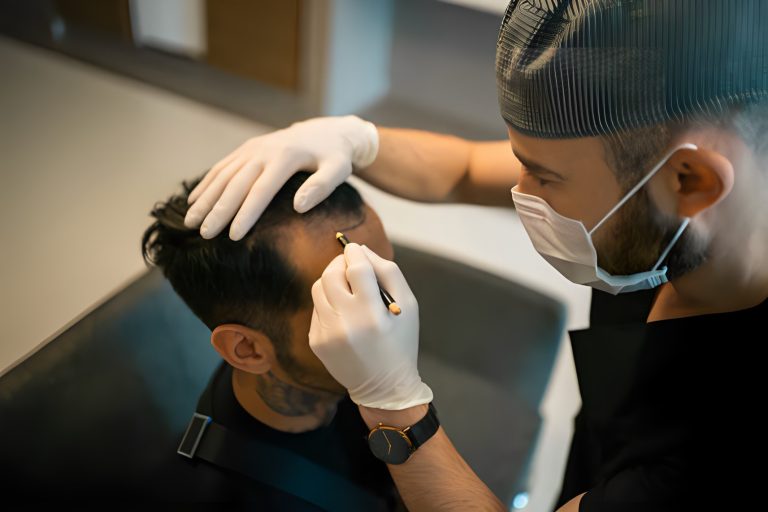A hair transplant is a surgical procedure that involves moving hair follicles from one part of the body, typically the back or sides of the scalp (donor area), to another part where hair is thinning or balding (recipient area). The primary goal of a hair transplant is to address androgenetic alopecia, commonly known as male-pattern baldness or female-pattern baldness, but it can also be used to restore hair in other areas of the body.
There are two main techniques used in hair transplantation:
- Follicular Unit Transplantation (FUT): Also known as the strip method, this involves removing a strip of skin with hair follicles from the donor area and then dissecting it into individual follicular units for transplantation.
- Follicular Unit Extraction (FUE): This method involves individually extracting hair follicles from the donor area using a punch tool. FUE is less invasive than FUT and leaves tiny, round scars that are less noticeable.
After the extraction, the surgeon implants the harvested follicles into small incisions made in the recipient area. The transplanted hair then grows naturally over time, providing a more permanent solution to hair loss.
Hair transplants are typically performed in a clinic or surgical center under local anesthesia. The success of the procedure depends on various factors, including the surgeon’s skill, the patient’s hair quality, and the overall health of the patient. It’s important for individuals considering a hair transplant to have realistic expectations about the outcomes and to consult with a qualified and experienced surgeon.
How much do hair transplants cost?
The cost of a hair transplant can vary widely depending on various factors such as the geographic location of the clinic, the experience and reputation of the surgeon, the technique used (FUT or FUE), the number of grafts needed, and the extent of hair loss. Additionally, the cost may also include pre-operative consultations, post-operative care, and any necessary medications.
As of my last knowledge update in January 2022, in the United States, hair transplant costs can range from a few thousand dollars to several thousand dollars. On average, the cost per graft in the U.S. can be in the range of $4 to $10 or more. The total cost is often calculated based on the number of grafts needed, and prices can vary significantly from one clinic to another.
It’s important to note that prices can differ in other countries as well. Some individuals may choose to travel to other countries where medical procedures, including hair transplants, may be more affordable. However, when considering medical tourism, it’s crucial to thoroughly research the qualifications and reputation of the clinic and surgeon.
It’s advisable to consult with several qualified surgeons, obtain detailed cost estimates, and discuss the specific factors that may affect the overall cost of the procedure. Keep in mind that the cost of a hair transplant should not be the sole determining factor; the surgeon’s experience and the quality of care provided are equally important considerations. Additionally, prices may have changed since my last update, so it’s a good idea to check with clinics directly for the most current information.
Can hair transplant work for a guy with very thin hair
Hair transplants can be effective for individuals with very thin hair, but the success of the procedure depends on several factors. Here are some key considerations:
- Donor Hair Quality: The success of a hair transplant relies on the availability of healthy hair follicles for transplantation. If the donor area has a sufficient number of good-quality hair follicles, even if the hair is thin, a hair transplant can still be a viable option.
- Expectations: It’s essential for individuals with very thin hair to have realistic expectations about the outcome of the procedure. A hair transplant can improve the appearance of thinning areas, but it might not provide the same density as a head of naturally thick hair.
- Extent of Hair Loss: The success of a hair transplant also depends on the extent of hair loss. If the balding area is extensive, the available donor hair may not be enough to achieve the desired coverage.
- Hair Loss Progression: Before undergoing a hair transplant, it’s important to consider the potential for further hair loss in the future. A long-term plan should be discussed with the surgeon to address ongoing hair loss and to ensure that the transplanted hair retains its aesthetic appeal over time.
- Choice of Technique: The choice between FUT (strip method) and FUE (follicular unit extraction) can impact the outcome. FUE is generally less invasive and leaves smaller scars, which may be preferable for individuals with very thin hair.
It’s crucial to consult with a qualified and experienced hair transplant surgeon to assess individual suitability and to discuss realistic expectations. The surgeon can evaluate the donor area, discuss the available options, and provide insights into the potential results of the procedure. Keep in mind that not everyone is a suitable candidate for a hair transplant, and alternative treatments or options may be recommended based on individual circumstances.
Which is better, hair fixing or hair transplantation
The choice between hair fixing (non-surgical methods, such as wigs or hairpieces) and hair transplantation (a surgical procedure) depends on individual preferences, the extent of hair loss, budget considerations, and the desired long-term outcome. Each option has its own advantages and limitations. Here’s a comparison:
Hair Fixing:
- Non-Surgical: Hair fixing is a non-surgical, temporary solution to hair loss. It involves the use of wigs, hairpieces, or extensions to cover up bald or thinning areas.
- Immediate Results: Hair fixing provides immediate results, as the appearance of a full head of hair is achieved instantly.
- Cost: In general, hair fixing tends to be a more cost-effective solution compared to hair transplantation. However, ongoing maintenance and replacement costs should be considered.
- Non-Invasive: Hair fixing is non-invasive and does not require surgery. It may be a suitable option for those who are not ready for or not interested in a surgical procedure.
Hair Transplantation:
- Permanent Solution: Hair transplantation offers a more permanent solution to hair loss. The transplanted hair is typically resistant to further hair loss.
- Natural Appearance: When performed by a skilled surgeon, a hair transplant can provide a natural and lasting result that integrates well with existing hair.
- Surgical Procedure: Hair transplantation is a surgical procedure, which means there is a recovery period, and it involves certain risks and considerations. It also requires a sufficient donor area with healthy hair follicles.
- Long-Term Investment: While the upfront cost of a hair transplant can be higher, it may be considered a long-term investment as it addresses the root cause of hair loss.
The choice between hair fixing and hair transplantation is highly individual and depends on factors such as personal preferences, budget, and the specific characteristics of the individual’s hair loss. Consulting with a qualified hair restoration specialist can provide personalized guidance and help determine the most suitable option based on individual circumstances.
is hair transplant covered by insurance
In most cases, hair transplant procedures are considered elective and cosmetic surgeries, and as such, they are typically not covered by health insurance. Insurance policies usually do not cover procedures that are not deemed medically necessary.
However, there may be exceptions in certain situations. If hair loss is a result of a medical condition or treatment, such as burns, accidents, or certain medical treatments (e.g., chemotherapy), insurance coverage might be considered. In these cases, it’s essential to check with your insurance provider to determine whether they cover any portion of the expenses related to hair restoration procedures.
It’s important to note that insurance coverage policies can vary widely, and what is covered may depend on the specific terms and conditions of your insurance plan. It is recommended to contact your insurance provider directly to inquire about coverage for hair transplant procedures and to obtain detailed information on any potential reimbursement.
Keep in mind that elective cosmetic procedures, including most hair transplants, are typically paid for out of pocket by the individual seeking the treatment. If cost is a significant consideration, it’s advisable to discuss financing options with the chosen hair transplant clinic or explore other financing solutions that may be available.




